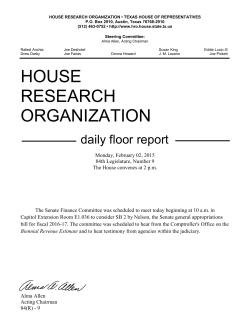
The observatory ALMA
The Atacama Large Millimetre Array (and PACE) José Afonso - PT ALMA National Community Day - 24 Feb 2015 The Atacama Large Millimetre Array The Atacama Large Millimetre Array The Atacama Large Millimetre Array A revolutionary research facility: 54x12m + 12x7m antennas; 16km maximum baselines ★ working over the 84 - 950 GHz range (300 μm - 3.5 mm) ★ max. spacial resolution: 5 mas ★ max. velocity resolution: <0.05 km/s ★ Capable to address most/all astronomy topics Built and operated by ESO, NA, EA, Chile The Atacama Large Millimetre Array Example: directly image of proto-planets in disks Birth of Planets Mplanet = MJup Mstar = 0.5 Msun Orbiting at 5AU Distance 50pc 5AU ALMA 850 GHz HST Leonardo Testi: The ALMA project, Copenhagen, 26 August 2010 Simulations by Wolf & D’Angelo (2005) The Atacama Large Millimetre Array Example: directly image of proto-planets in disks The Atacama Large Millimetre Array Example: Study the chemistry in SF regions Test 3mm ALMA data for the hot molecular core G34.26+0.15. The Atacama Large Millimetre Array Example: Study the chemistry in SF regions The Atacama Large Millimetre Array Example: ... and out to the highest redshifts Figure 2: Figure 2: ALMA 3 mm spectra of 26 SPT sources. The vertical axis is observed density Vieira etflux al. (2013) ALMA Early Science Cycle 3 Start: Oct 2015 - Sept 2016 Time Availability: 2100 hours Call: March 24 Deadline: April 23 (est.) Results: August Anticipated Capabilities: • >36x12m antennas + 10x7m antennas + 2x12m total power antennas • Bands 3, 4, 6, 7, 8, 9, 10 (3mm down to 0.35mm) • baselines up to 2 km for B8, 9, 10 • baselines up to 5 km for B7 • baselines up to 10 km for B3, 4, 6 • Single field + mosaics • polarization • mixed correlator modes Some non-standard modes: • Bands 8, 9 & 10 observations • Long baselines (> 2km) • Polarization • Spectral Scans • All ephemeris observations • Bands ≥ 7 with all narrow band spectral windows • Non-standard calibrations The ALMA Regional Centres The ALMA Regional Centres ARC Duties • Distribution of Call for Proposals • user support for proposal preparation • TAC procedures & technical feasibility • Assistance with phase II scheduling/execution observations • Data products support • Archive operations • ALMA helpdesk • community development and outreach The EU ALMA Regional Centre • Seven Nodes and one Centre of Expertise • Duties: user support (face2face proposal preparation and data reduction or archival research, meetings, workshops, Helpdesk); phase II; community preparation; outreach. • For CoE: also develop unique expertise; increase ALMA national usage The Portuguese ALMA Centre of Expertise - PACE PACE main duties • expertise strengthening (e.g.: planetary atmospheres and data mining) • ALMA promotion to the national community (national community days, visits to institutions, webpage) • f2f (proposal preparation and archival research) • QA2, tutoring in EU-ARC activities • EU ARC activities (incl. ARC all hands) The Portuguese ALMA Centre of Expertise - PACE Cycle-2 PACE supported ALMA programs: • Spoon et al. “Detecting in CO(1-0) the Strongest Molecular Outflow found by Herschel in the Southern Sky” • Triester et al. “Caught in a Cosmic Tango: ALMA Spies the Interplay Between Dual AGN in Merger Remnant Galaxies” • Bauer et al. “Lensing Through Cosmic Time: ALMA Constraints on "Normal" Galaxies in the HST Frontier Fields” • Ibar et al. “A resolved view to star-forming H-𝜶 galaxies at z = 1.47-2.23: exploiting the synergy between ALMA and AO-IFU” • Stott et al. “Probing the z=1.0 Kennicutt-Schmidt law by combining ALMA and VLT KMOS observations” The Portuguese ALMA Centre of Expertise - PACE ALMA-PT results being produced... Astronomy & Astrophysics A&A 568, A92 (2014) DOI: 10.1051/0004-6361/201424410 c ESO 2014 ⃝ Herschel -ATLAS and ALMA HATLAS J142935.3-002836, a lensed major merger at redshift 1.027 Hugo Messias1,2 , Simon Dye3 , Neil Nagar1 , Gustavo Orellana1 , R. Shane Bussmann4 , Jae Calanog5 , Helmut Dannerbauer6 , Hai Fu7 , Edo Ibar8 , Andrew Inohara5 , R. J. Ivison9,10 , Mattia Negrello11 , Dominik A. Riechers12,13 , Yun-Kyeong Sheen1 , James E. Aguirre14 , Simon Amber15 , Mark Birkinshaw16,17 , Nathan Bourne3 , Charles M. Bradford18 , Dave L. Clements19 , Asantha Cooray5,12 , Gianfranco De Zotti11 , Ricardo Demarco1 , Loretta Dunne20,9 , Stephen Eales21 , Simone Fleuren22 , Julia Kamenetzky23 , Roxana E. Lupu14 , Steve J. Maddox20,9 , Daniel P. Marrone24 , Michał J. Michałowski9 , Eric J. Murphy25 , Hien T. Nguyen18 , Alain Omont26 , Kate Rowlands27 , Dan Smith28 , Matt Smith21 , Elisabetta Valiante21 , and Joaquin D. Vieira29 (Affiliations can be found after the references) Received 16 June 2014 / Accepted 8 July 2014 ABSTRACT Context. The submillimetre-bright galaxy population is believed to comprise, aside from local galaxies and radio-loud sources, intrinsically active star-forming galaxies, the brightest of which are lensed gravitationally. The latter enable studies at a level of detail beyond what is usually possible by the observation facility. Aims. This work focuses on one of these lensed systems, HATLAS J142935.3−002836 (H1429−0028), selected in the Herschel-ATLAS field. Gathering a rich, multi-wavelength dataset, we aim to confirm the lensing hypothesis and model the background source’s morphology and dynam- The Portuguese ALMA Centre of Expertise - PACE Official Site: http://pace.oal.ul.pt PACE people PACE Coordination: José Afonso PACE Lead Scientist: Hugo Messias PACE Astronomers: Ciro Pappalardo, Silvio Lorenzoni, Elvira Leonardo, Pedro Machado, David Sobral Technical Support: Carlos Santos Administrative Support: Sandra Homem Outreach: João Retrê The Atacama Large Millimetre Array (and PACE) José Afonso - PT ALMA National Community Day - 24 Feb 2015
© Copyright 2025









